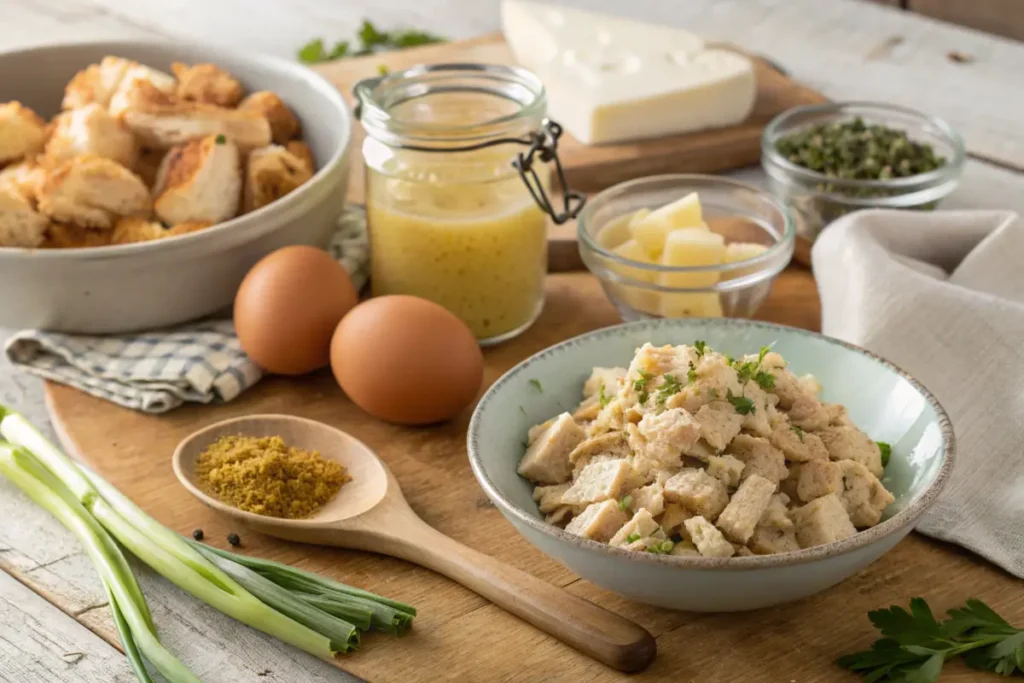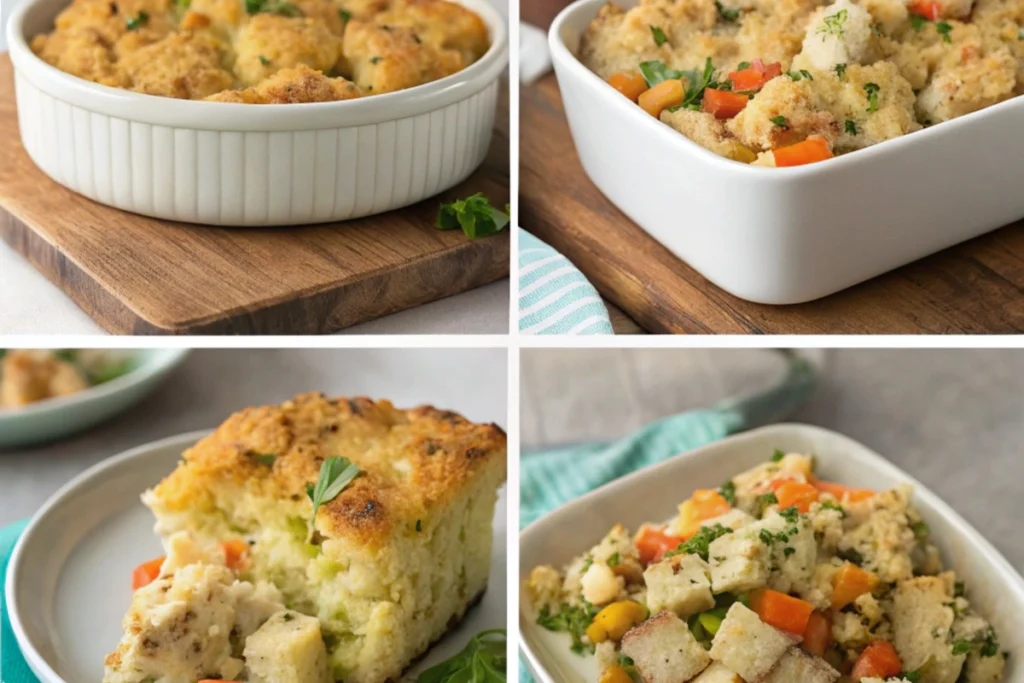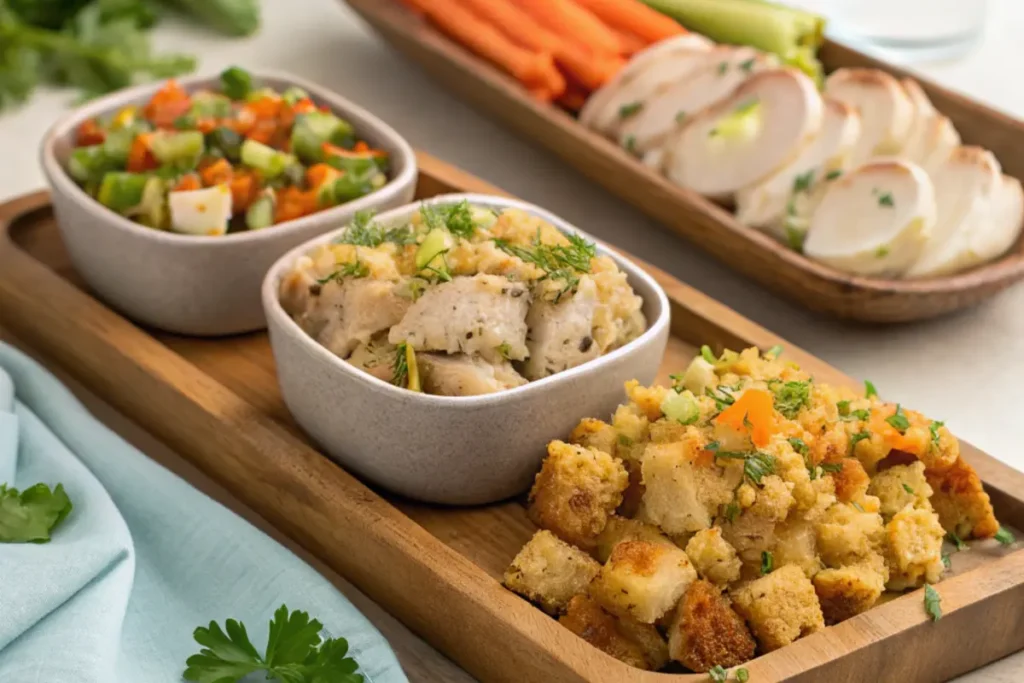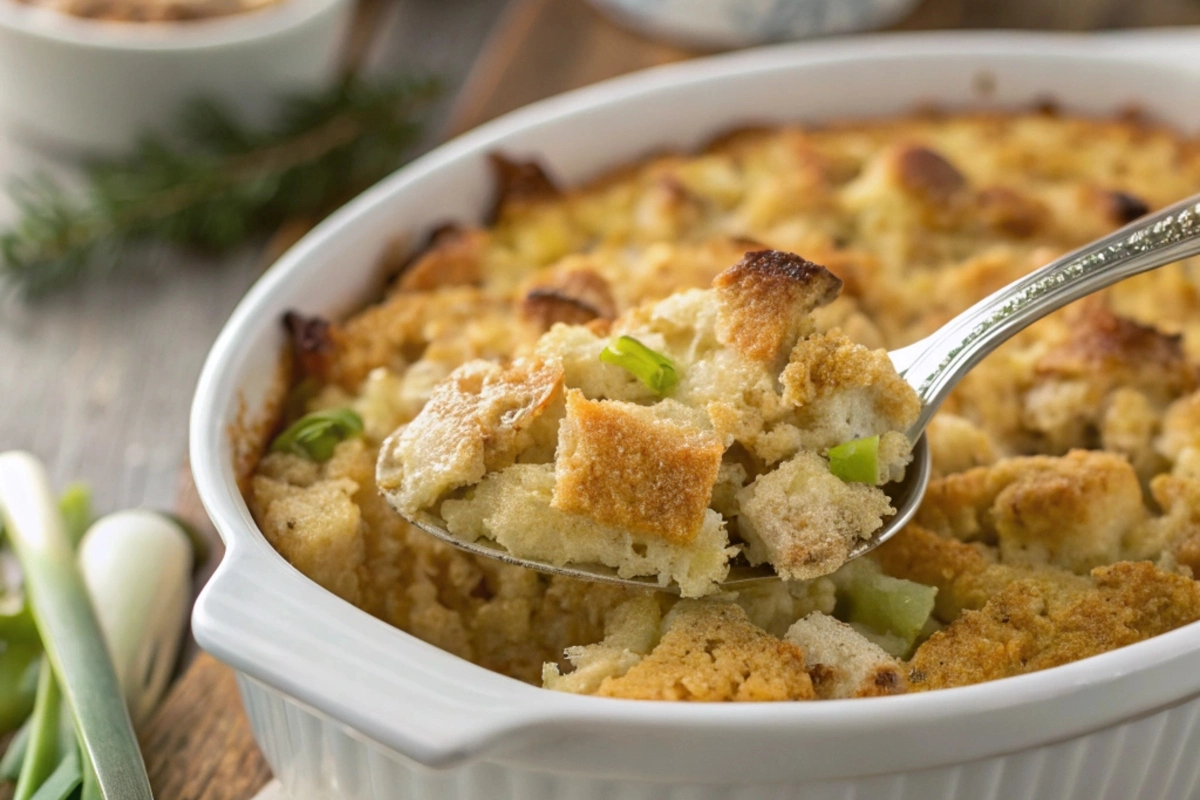Looking for the perfect chicken dressing recipe to elevate your holiday table or add a touch of comfort to a regular family dinner? Well, you’re in for a treat! This guide takes you through everything you need to know—from understanding what makes dressing different from stuffing, to mastering classic ingredients, and exploring variations that cater to every diet. Let’s dive in and uncover the secrets to crafting a dressing that’s moist, flavorful, and absolutely irresistible.
What Is Chicken Dressing?
Understanding Chicken Dressing
Chicken dressing is a beloved dish, especially in Southern cuisine, where it often stars during Thanksgiving and Christmas meals. But you don’t need a holiday to enjoy this savory side dish! Dressing typically combines crumbled bread, tender shredded chicken, aromatic herbs like sage and thyme, and a rich broth. Unlike stuffing, which is cooked inside a bird, dressing is baked separately for better texture and safety.
This versatile dish can also be adapted to fit different preferences, like using gluten-free bread or skipping dairy altogether. It’s a comfort food staple that balances savory, herby, and lightly spiced flavors, making it a crowd-pleaser at any gathering.
History and Origins of Chicken Dressing
The roots of chicken dressing trace back to Southern traditions, where cornbread frequently takes center stage. Historically, this beloved dish evolved as a practical way to repurpose stale bread and leftover poultry. Over time, it transformed into something both hearty and satisfying, becoming a staple of holiday meals and comfort food gatherings alike.. Over time, cooks added ingredients like sautéed onions, celery, and eggs to enhance both flavor and texture.
Today, chicken dressing has spread beyond its Southern origins to become a favorite in homes across the country. While some recipes stick to classic cornbread bases, others incorporate white bread, biscuits, or even crackers for a unique twist. Its rich history only adds to its timeless appeal, making it a dish steeped in both flavor and nostalgia.
Ingredients and Step-by-Step Cooking Instructions
Essential Ingredients for a Perfect Chicken Dressing Recipe
Creating the ultimate chicken dressing recipe starts with high-quality, flavorful ingredients. Here’s what you’ll need to craft a dish that’s sure to impress:
Ingredients List
- 6 cups crumbled cornbread (prepared a day before, dried for best texture)
- 4 cups shredded cooked chicken (boiled or roasted for added flavor)
- 1 cup diced celery
- 1 cup finely chopped onion
- 4 cups chicken broth (homemade or low-sodium store-bought)
- 3 large eggs, beaten
- 1/2 cup unsalted butter, melted
- 1 tbsp dried sage (or more to taste)
- 1 tsp thyme
- 1 tsp poultry seasoning
- Salt and pepper to taste
- Optional: 1/2 cup diced bell peppers, 1/2 cup chopped parsley for garnish

Step-by-Step Cooking Instructions
This chicken dressing recipe is straightforward to follow and absolutely bursting with flavor. By carefully following each step, you’ll achieve the perfect balance of texture and taste. Moreover, the instructions are designed to guide you seamlessly through the process, ensuring success every time. So, let’s dive in and get started!
Step 1: Prepare the Cornbread Base
Begin by preheating your oven to 350°F (175°C). Crumble the prepared cornbread into small, bite-sized pieces and spread them evenly on a baking sheet. If your cornbread wasn’t made a day earlier, allow it to dry out in the oven for a few minutes. Dry bread absorbs flavors better and ensures the dressing doesn’t turn mushy.
Step 2: Cook and Prep the Chicken
Start with raw or pre-cooked chicken, depending on what you have available. If raw, either boil or roast it until fully cooked. Once it cools, shred the chicken into small, tender pieces. For extra flavor, save some of the broth from boiling the chicken; this will be used later in the recipe.
Step 3: Sauté Vegetables
Melt 2 tablespoons of butter in a skillet over medium heat. Add the diced celery and onions, stirring occasionally until they soften and release their aroma. This should take about 5–7 minutes. Remove the vegetables from heat and set aside.
Step 4: Combine Ingredients
In a large mixing bowl, combine the crumbled cornbread, shredded chicken, sautéed vegetables, and seasonings like sage, thyme, and poultry seasoning. Slowly pour in the chicken broth while stirring gently. The mixture should be moist enough to hold together but not overly wet. Next, fold in the beaten eggs and melted butter, making sure everything is evenly incorporated.
Step 5: Bake the Dressing
Prepare a 9×13-inch baking dish by greasing it with butter or cooking spray. Transfer the mixture into the dish, spreading it out evenly without pressing it down too tightly. Cover the dish with foil and bake at 350°F (175°C) for 30 minutes. Afterward, remove the foil and bake for another 15–20 minutes until the top is golden brown and slightly crisp.
Step 6: Garnish and Serve
Once the dressing is done, allow it to rest for 5–10 minutes to set. For a finishing touch, sprinkle freshly chopped parsley over the top. Serve warm and enjoy this flavorful dish as a centerpiece or a perfect side for your meal.
Nutritional Content (Per 100g)
Here’s the nutritional breakdown for this chicken dressing recipe:
| Nutrient | Amount |
|---|---|
| Calories | 190 kcal |
| Protein | 10 g |
| Fat | 8 g |
| Saturated Fat | 3 g |
| Carbohydrates | 19 g |
| Fiber | 2 g |
| Sodium | 400 mg |
| Sugar | 2 g |
Ingredients Breakdown
Essential Ingredients for a Perfect Chicken Dressing Recipe
To make the perfect chicken dressing recipe, the right ingredients are key. Every component plays a vital role in creating that savory, flavorful dish that will have everyone coming back for more. From the bread base to the seasonings and optional add-ins, let’s break down the essentials that will elevate your chicken dressing to perfection.
Choosing the Right Bread
The type of bread you use is the foundation of any good dressing. The bread not only provides texture but also absorbs all the delicious flavors from the seasonings, chicken, and broth.
- Cornbread: For a traditional Southern-style chicken dressing, cornbread is undoubtedly the best choice. Its slightly sweet and crumbly texture not only enhances the savory components but also provides a delightful contrast. Whether you prefer to make cornbread from scratch or opt for a store-bought version, both work beautifully. However, to achieve the ideal texture, it’s essential to dry it out slightly by leaving it uncovered overnight. This simple step ensures that the bread absorbs the liquid evenly without becoming soggy.
- White Bread: Some prefer a milder option, and white bread works beautifully here too. It’s more neutral in flavor, allowing the seasonings and chicken to shine. To prepare it, simply cut the bread into cubes and dry it out for the best results.
- Tips for Prepping the Bread: No matter which bread you choose, make sure it’s a bit stale or dried out. Fresh bread can turn soggy in the dressing, so leave it out for a day or toast it in the oven for a few minutes before you crumble or cube it. This step ensures your dressing holds its shape and texture.
Selecting Chicken Cuts
The next critical ingredient is the chicken. The cuts you select will influence the texture and flavor of the dish.
- Best Chicken Cuts for Dressing: The best cuts of chicken for chicken dressing recipes are those that yield tender, flavorful meat. Chicken breasts are commonly used, but thighs are an excellent option for a richer flavor. Boneless, skinless chicken breasts are easy to shred, while thighs offer a juicier, more flavorful bite.
- Cooking Methods for Tender Chicken: To achieve tender chicken for your dressing, focus on using gentle cooking methods. Start by choosing from boiling, roasting, or poaching, as each technique has its own benefits. For instance, boiling works particularly well because it not only keeps the chicken moist but also provides flavorful broth to use in your dressing. Alternatively, roasting adds a deeper flavor, while poaching ensures the chicken remains soft and juicy. No matter which method you select, handle the chicken with care to preserve its texture and taste. If you prefer to roast, rub the chicken with some olive oil and seasoning, then bake it at 375°F (190°C) until the meat is fully cooked. After the chicken is cooked, let it cool slightly before shredding it into bite-sized pieces to mix into your dressing.
The Role of Herbs and Spices
The right combination of seasonings brings your chicken dressing recipe to life. Herbs like sage, thyme, and rosemary complement the chicken, while other spices balance the richness of the bread.
- Essential Seasonings:
- Sage is the star herb in many dressing recipes, offering an earthy, slightly peppery flavor.
- Thyme has a subtle, savory flavor that complements the chicken and the bread perfectly.
- Poultry seasoning is often a go-to mix that combines sage, thyme, marjoram, and sometimes rosemary, making it a one-stop solution for seasoning your dressing.
- Substitutions for Common Spices:
- If you’re out of poultry seasoning, simply combine equal parts sage and thyme, or try Italian seasoning as an alternative.
- For a deeper flavor, you can use rosemary or marjoram.
- For a touch of heat, consider adding a pinch of cayenne pepper or a dash of crushed red pepper flakes.
The seasonings are essential, so don’t be shy about adjusting them to match your tastes. The right amount of seasoning makes all the difference.
Additional Flavor Boosters
While the core ingredients make up the backbone of your chicken dressing, there are several add-ins you can include to kick up the flavor.
- Celery: Adding celery gives your dressing a nice crunch and a subtle bitterness that balances the richness of the bread and chicken.
- Onions: Sautéed onions add sweetness and depth of flavor, especially when cooked with a little butter.
- Stock: Use chicken stock instead of water to enhance the flavor. Homemade stock is the best, but low-sodium store-bought broth works fine if you’re in a pinch. For extra richness, consider using vegetable broth or even a bit of turkey stock if available.
For an extra twist, try adding diced bell peppers or a handful of chopped mushrooms for additional texture and flavor.

Step-by-Step Preparation
How to Prepare the Chicken Dressing Recipe
Creating a chicken dressing recipe that’s moist, flavorful, and perfectly textured requires attention to detail at each step. Follow this comprehensive guide to ensure every bite is a success!
Preparing the Bread Base
The bread is the heart of your dressing, so proper preparation is key:
- Dry the Bread: If you haven’t pre-dried the bread, spread your crumbled cornbread or cubed white bread on a baking sheet. Leave it out overnight or toast it lightly in the oven at 250°F (120°C) for 15–20 minutes. This prevents the bread from becoming mushy when mixed with broth.
- Crumble the Bread: Once dry, crumble the cornbread or cut the white bread into uniform pieces. Keep the crumbles moderately small to create a balanced texture, but not so fine that it resembles powder.
Cooking and Prepping the Chicken
Follow these steps for tender, flavorful chicken:
- Boiling the Chicken: Place chicken breasts or thighs in a pot with enough water to cover them. Add a pinch of salt, some celery, onions, or carrots for added flavor, and bring to a boil. Lower the heat and simmer for 15–20 minutes until the chicken is fully cooked.
- Shredding the Chicken: Remove the chicken from the pot and let it cool slightly. Use two forks or your hands to shred the meat into bite-sized pieces. Save the broth from boiling—it’ll be used later for added richness in the dressing.
Pro Tip: For an extra boost of flavor, roast the chicken instead of boiling. Season with salt, pepper, and poultry seasoning, then bake at 375°F (190°C) for 25–30 minutes before shredding.
Mixing Ingredients for a Balanced Flavor
The magic happens when all the ingredients come together:
- Combine the Dry Ingredients: To start, grab a large mixing bowl and combine the crumbled bread, shredded chicken, and sautéed vegetables, such as onions and celery. Next, add Add herbs such as sage, thyme, and poultry seasoning to amplify the dish’s flavor and complement the other ingredients. Afterward, thoroughly mix these elements together to ensure an even distribution of flavors. This step creates a solid and aromatic base, which you can later enhance with the liquid components. As a result, the mixture will achieve a perfect balance, making it ready for the next stage in your preparation process.
- Incorporate the Wet Ingredients: Gradually pour in the chicken broth, stirring as you go to reach a moist consistency. Avoid making the mixture too wet—it should hold its shape when pressed. Add beaten eggs and melted butter, stirring gently to combine everything.
- Taste and Adjust: Before transferring the mixture to your baking dish, taste it. Adjust the seasoning with salt and pepper as needed.
Baking the Dressing to Perfection
- Prepare the Dish: Grease a 9×13-inch baking dish with butter or cooking spray to prevent sticking.
- Transfer the Mixture: Pour the prepared mixture evenly into the baking dish, pressing gently to spread it out without packing it down too tightly.
- Bake: Cover the dish with aluminum foil and bake at 350°F (175°C) for 30 minutes. This allows the flavors to meld while preventing the top from drying out.
- Finish Baking: Remove the foil and bake for another 15–20 minutes, or until the top is golden brown and slightly crispy.
- Rest Before Serving: Let the dressing rest for 5–10 minutes before serving. This helps it set and makes it easier to slice and serve.
Recipe Variations
Creative Variations of Chicken Dressing
Dressing is incredibly versatile, which makes it simple to customize for various dietary needs or, alternatively, to explore exciting new flavor profiles. Additionally, its adaptability allows you to tailor it to suit personal preferences or special occasions. Below are a few creative twists to elevate the traditional chicken dressing recipe.

Southern-Style Chicken and Cornbread Dressing
The hallmark of Southern-style dressing is its cornbread base, combined with rich seasonings:
- Use 100% cornbread instead of mixing with white bread.
- Include sautéed green bell peppers for a deeper flavor.
- Add 1/4 cup of crumbled cooked sausage for a Southern twist (optional).
- Increase the amount of sage to amplify the earthy, herby notes.
Pro Tip: Southern-style dressing pairs perfectly with turkey gravy and cranberry sauce.
Gluten-Free Chicken Dressing Options
For gluten-sensitive individuals, it’s easy to adapt the recipe:
- Substitute cornbread and white bread with gluten-free cornbread or gluten-free bread cubes.
- Ensure the chicken broth used is gluten-free (some store-bought broths may contain gluten).
- Follow the same preparation steps as the traditional recipe to maintain the flavor.
Vegetarian-Friendly Dressing Alternatives
For those who prefer a meat-free option, try this simple swap:
- Replace shredded chicken with sautéed mushrooms, tofu crumbles, or plant-based chicken alternatives.
- Use vegetable broth instead of chicken broth to maintain a rich, savory base.
- Add extra vegetables like diced carrots, peas, or bell peppers for a hearty texture.
Dairy-Free Chicken Dressing
If you’re avoiding dairy, here’s how to adjust the recipe:
- Replace butter with plant-based margarine or olive oil.
- Ensure the cornbread used is dairy-free (some mixes may contain milk powder).
- Use almond milk or coconut milk to replace any dairy in pre-made bread or cornbread recipes.
Serving Suggestions
Best Ways to Serve Chicken Dressing
A chicken dressing recipe shines as the centerpiece of many meals, whether it’s a holiday feast or a casual family dinner. Pairing it with the right side dishes enhances its flavors and creates a well-rounded plate.
- Holiday Pairings: For a festive feast, serve chicken dressing alongside traditional favorites such as mashed potatoes, green beans, sweet potato casserole, and cranberry sauce. Not only do these classic sides complement the savory richness of the dressing, but they also add a delightful balance of sweet and tangy flavors to the meal.
- Casual Meals: For a weeknight dinner, pair chicken dressing with a simple garden salad and a side of steamed vegetables. It also works beautifully as a topping for baked chicken or turkey breast.
- Serving Tip: Garnish the dressing with fresh herbs like parsley or thyme before serving to add a pop of color and a hint of freshness.
Beverage Pairings
While chicken dressing is typically served with hearty holiday meals, it pairs well with a variety of drinks that complement its savory flavors:
- Non-Alcoholic Beverages: Opt for sparkling water with lemon, apple cider, or a lightly sweetened iced tea to refresh your palate.
- Warm Beverages: If serving during cooler months, try pairing it with herbal tea or hot apple cider to create a cozy meal.
Storage and Reheating
Proper Storage Tips for Chicken Dressing
Leftover chicken dressing is a treat, but proper storage is key to maintaining its texture and flavor:
- Refrigeration: Store leftover dressing in an airtight container or tightly covered with aluminum foil. Place it in the refrigerator within two hours of baking to prevent spoilage.
- Duration: Dressing stays fresh for up to 3–4 days when refrigerated.
Pro Tip: Divide the dressing into smaller portions before storing. This makes it easier to reheat only what you need.
Reheating Leftovers Without Drying Out
Reheating dressing can sometimes dry it out, but these methods will help keep it moist and delicious:
- Oven Method:
- Preheat the oven to 350°F (175°C).
- Place the dressing in an oven-safe dish, sprinkle a little broth or water over it, and cover with foil.
- Heat for 15–20 minutes or until warmed through.
- Microwave Method:
- Place a portion of dressing in a microwave-safe dish and cover with a microwave-safe lid or damp paper towel.
- Heat on medium power in 30-second intervals, stirring gently between each, until hot.
Can You Freeze Chicken Dressing?
Yes, chicken dressing freezes wonderfully, making it an excellent make-ahead dish for busy days or holiday prep:
- Freezing Instructions:
- Allow the dressing to cool completely after baking.
- Portion it into airtight freezer-safe containers or heavy-duty freezer bags.
- Label the containers with the date and freeze for up to 2–3 months.
- Defrosting Tips:
- Thaw the dressing in the refrigerator overnight.
- Reheat using the oven or microwave methods mentioned above to revive its flavor and texture.
Proper storage and reheating techniques not only keep your dressing fresh but also ensure it remains flavorful and moist, even after several days. In addition to these tips, understanding the best practices can help you save time while preserving the dish’s quality. Up next, let’s dive into the FAQs section, where we’ll answer some of the most common questions about chicken dressing recipes to help you master this classic dish!
FAQs About Chicken Dressing Recipes
When it comes to making the perfect chicken dressing recipe, questions often arise about preparation, variations, and safety. Below are answers to the most frequently asked questions to help you master this beloved dish.
How Do I Prevent My Dressing From Becoming Too Dry?
Dry dressing is a common issue, but it’s easy to avoid with these tips:
- Add Enough Liquid: Ensure your bread mixture is moist before baking by gradually adding chicken broth. The mixture should be damp but not soupy.
- Cover While Baking: Cover the dish with foil for the first part of baking to trap moisture, then uncover to crisp the top.
- Incorporate Fat: Ingredients like melted butter or eggs help retain moisture throughout the dish.
Can I Prepare Chicken Dressing in Advance?
Yes, chicken dressing can be prepared ahead of time, making it ideal for busy holiday schedules:
- Assemble in Advance: Combine all ingredients and store the unbaked mixture in the refrigerator for up to 24 hours.
- Baking Later: When ready to bake, bring the mixture to room temperature and bake as usual.
Pro Tip: Avoid adding too much liquid if prepping early, as the bread will continue to absorb moisture while it sits.
What Is the Difference Between Stuffing and Dressing?
The terms “stuffing” and “dressing” are often used interchangeably, but there’s a key distinction:
- Stuffing: Cooked inside the turkey or chicken, absorbing the bird’s juices.
- Dressing: Baked separately in a dish, allowing for a crisp top and a more controlled texture.
In some regions, especially in the South, “dressing” is the preferred term regardless of where it’s cooked.
Can Chicken Dressing Be Made Gluten-Free?
Absolutely! To make gluten-free dressing:
- Substitute regular bread with gluten-free bread or gluten-free cornbread.
- Double-check that your chicken broth is gluten-free (some brands may contain gluten).
- Follow the same steps for preparation and baking.
What Herbs Are Best for Chicken Dressing?
Herbs play a crucial role in enhancing the flavor of chicken dressing:
- Sage: The most popular herb for dressing, offering earthy, peppery notes.
- Thyme: Adds a subtle savory undertone.
- Parsley: Great for freshness and garnish.
- Rosemary: Provides a bold, aromatic touch but should be used sparingly.
If you don’t have these on hand, poultry seasoning is a convenient blend that works perfectly.
Is It Safe to Bake Dressing Inside the Turkey?
Cooking dressing inside a turkey can be risky due to food safety concerns:
- Risk of Undercooking: The stuffing inside the turkey may not reach the safe internal temperature of 165°F (74°C), leading to bacteria like salmonella.
- Alternative: For safety, bake dressing in a separate dish and serve alongside the turkey.
If you prefer the traditional method, use a meat thermometer to ensure the stuffing reaches the proper temperature.

